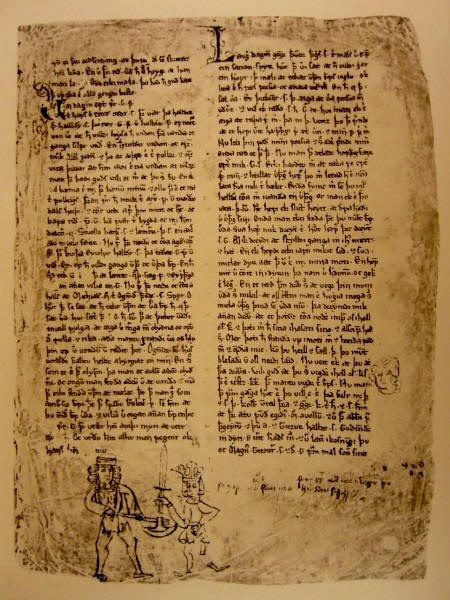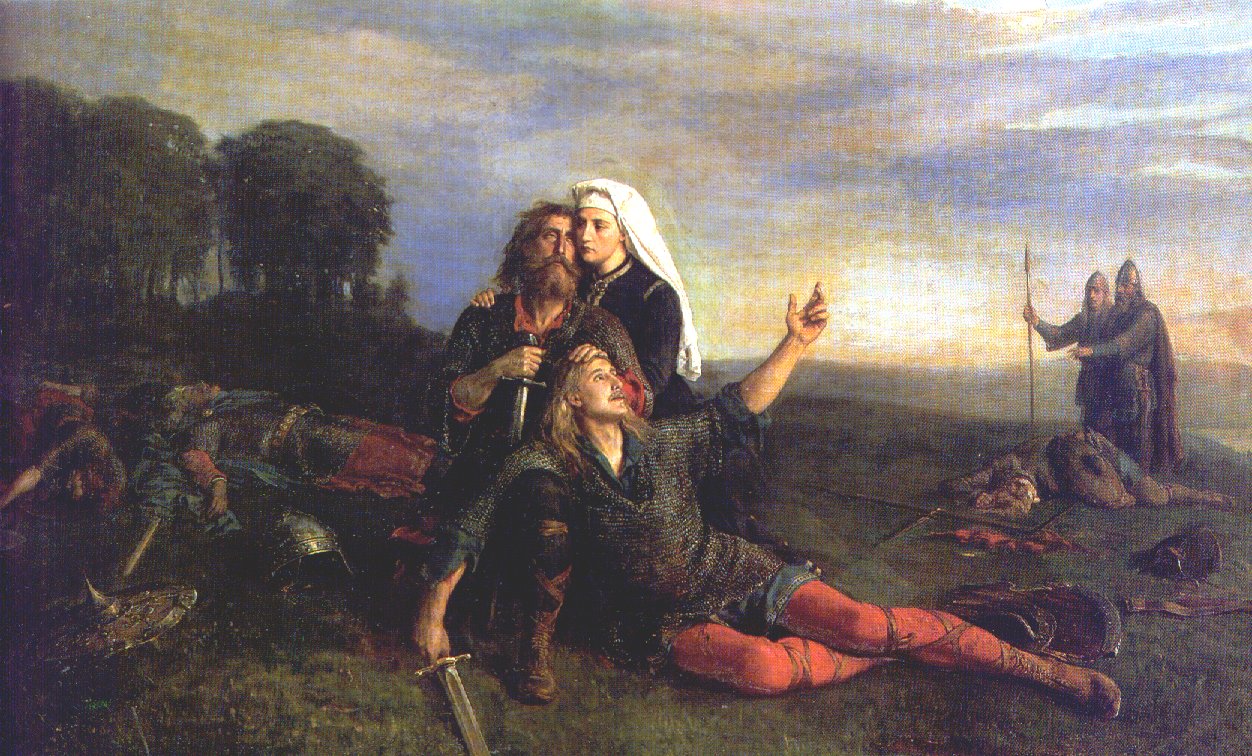|
Huldar Saga
''Huldar saga'' is the name of a lost Icelandic saga said to have been told by Sturla Þórðarson in 1263. Though the saga is no longer extant, the account of its telling has attracted extensive commentary as a rare account of medieval Icelandic saga-performance. ''Huldar saga'' is also one of the names of at least one post-medieval Icelandic saga in the same genre. Sturla Þórðarson's ''Huldar saga'' This medieval ''Huldar saga'' is mentioned in ''Sturlu þáttr'', a short tale about Sturla Þórðarson that survives only in the version of ''Sturlunga saga'' attested in the manuscript Reykjafjarðarbók, indicating that it does not belong to the written archetype of the saga. It depicts Sturla winning the favour of King Magnus VI of Norway through his storytelling; in this, it is similar to many of the '' Íslendingaþættir''. It is assumed that the saga was akin to the ''fornaldarsögur'', but there is debate as to whether Sturla knew it only orally or whether it was ever w ... [...More Info...] [...Related Items...] OR: [Wikipedia] [Google] [Baidu] |
Icelandic Saga
The sagas of Icelanders ( is, Íslendingasögur, ), also known as family sagas, are one genre of Icelandic sagas. They are prose narratives mostly based on historical events that mostly took place in Iceland in the ninth, tenth, and early eleventh centuries, during the so-called Saga Age. They were written in Old Icelandic, a western dialect of Old Norse. They are the best-known specimens of Icelandic literature. They are focused on history, especially genealogical and family history. They reflect the struggle and conflict that arose within the societies of the early generations of Icelandic settlers. The Icelandic sagas are valuable and unique historical sources about medieval Scandinavian societies and kingdoms, in particular in regards to pre-Christian religion and culture. Eventually many of these Icelandic sagas were recorded, mostly in the 13th and 14th centuries. The 'authors', or rather recorders of these sagas are largely unknown. One saga, ''Egil's Saga'', is beli ... [...More Info...] [...Related Items...] OR: [Wikipedia] [Google] [Baidu] |
Sturla Þórðarson
Sturla Þórðarson ( ; ; 29 July 1214–30 July 1284) was an Icelandic chieftain and writer of sagas and contemporary history during the 13th century. Biography The life of Sturla Þórðarson was chronicled in the Sturlunga saga. Sturla was the son of Icelandic chieftain Þórður Sturluson and his mistress Þóra, and grandson of Sturla Þórðarson the elder. He was a nephew and pupil of the famous saga-writer Snorri Sturluson. His brother was Icelandic skald and scholar Ólafur Þórðarson hvítaskáld. He fought alongside Þórður kakali Sighvatsson during the Age of the Sturlungs. Sturla was appointed law speaker over all of Iceland for a brief period after the dissolution of the Icelandic Commonwealth, and wrote the law book '' Járnsíða.'' Like his uncle, Snorri, and his brother, Óláfr, Sturla was a prolific poet. He is reported in ''Sturlu þáttr'' as telling a saga called ''Huldar saga''.Úlfar Bragason,Um hvað fjallaði Huldar saga?', ''Tímarit Máls og ... [...More Info...] [...Related Items...] OR: [Wikipedia] [Google] [Baidu] |
Sturlunga Saga
''Sturlunga saga'' (often called simply ''Sturlunga'') is a collection of Icelandic sagas by various authors from the 12th and 13th centuries; it was assembled in about 1300. It mostly deals with the story of the Sturlungs, a powerful family clan during the Age of the Sturlungs period of the Icelandic Commonwealth. ''Sturlunga saga'' mostly covers the history of Iceland between 1117 and 1264."Sturlunga saga", Rudolf Simek and Hermann Pálsson, ''Lexikon der altnordischen Literatur'', Kröners Taschenausgabe 490, Stuttgart: Kröner, 1987, , pp. 339–41 It begins with '' Geirmundar þáttr heljarskinns'', the legend of Geirmundr heljarskinn, a regional ruler in late 9th-century Norway, who moves to Iceland to escape the growing power of King Harald Finehair. Jan de Vries, ''Altnordische Literaturgeschichte'', Volume 2 ''Die Literatur von etwa 1150 bis 1300; die Spätzeit nach 1300'', Grundriss der germanischen Philologie 16, 2nd ed. Berlin: de Gruyter, 1967, OCLC 270854789, p ... [...More Info...] [...Related Items...] OR: [Wikipedia] [Google] [Baidu] |
Magnus VI Of Norway
Magnus Haakonsson ( non, Magnús Hákonarson, no, Magnus Håkonsson, label=Modern Norwegian; 1 (or 3) May 1238 – 9 May 1280) was King of Norway (as Magnus VI) from 1263 to 1280 (junior king from 1257). One of his greatest achievements was the modernisation and nationalisation of the Norwegian law-code, after which he is known as Magnus the Law-mender ( non, Magnús lagabœtir, links=no, no, Magnus Lagabøte, label=Modern Norwegian). He was the first Norwegian monarch known to have used an ordinal number, although originally counting himself as "IV". Early life He was the youngest son of King Håkon Håkonsson and his wife Margaret Skulesdatter. He was born in Tunsberg and was baptised in May 1238. He spent most of his upbringing in Bergen. In 1257 his older brother Håkon died, leaving Magnus the heir-apparent to the kingdom. His father gave him the title of king the same year. On 11 September 1261, he married Ingeborg, the daughter of King Eric IV of Denmark, after she was p ... [...More Info...] [...Related Items...] OR: [Wikipedia] [Google] [Baidu] |
Fornaldarsögur
A legendary saga or ''fornaldarsaga'' (literally, "story/history of the ancient era") is a Norse saga that, unlike the Icelanders' sagas, takes place before the settlement of Iceland.The article ''Fornaldarsagor'' in ''Nationalencyklopedin'' (1991) There are some exceptions, such as '' Yngvars saga víðförla'', which takes place in the 11th century. The sagas were probably all written in Iceland, from about the middle of the 13th century to about 1400, although it is possible that some may be of a later date,Einar Ól. Sveinsson, "Fornaldarsögur", in ''Kulturhistorisk leksikon for nordisk middelalder fra vikingtid til reformasjonstid, bd. 4'' (Copenhagen, 1959) such as ''Hrólfs saga kraka''. Description of the sagas In terms of form, ''fornaldarsögur'' are similar to various other saga-genres, but tend towards fairly linear, episodic narratives. Like sagas in other genres, many quote verse, but in the ''fornaldarsögur'' that verse is almost invariably in the metre of Eddaic v ... [...More Info...] [...Related Items...] OR: [Wikipedia] [Google] [Baidu] |
Huld
In Scandinavian mythology, Huld is only referenced by ''völva'' or ''seiðkona'', that is a woman who practiced the seiðr. She is mentioned in the ''Ynglinga saga'', ''Sturlunga saga'' and a late medieval Icelandic tale.The article Huld' in ''Nordisk familjebok'' (1909). In the latter source, she is Odin's mistress and the mother of the demi-goddesses Þorgerðr and Irpa. As her name suggests, Huld may be in origin the same being as the Hulder and the German Holda. Attestations In the ''Ynglinga saga'' it is related that she was first hired to kill the Swedish king Vanlade, by his wife Drífa. She " hag-rode" him to death. Snorri also quoted some lines from ''Ynglingatal'' composed in the 9th century: Later she was hired by Vanlade's grandchildren to kill his son Visbur. It is said in ''Sturlunga saga'' that Sturla Þórðarson entertained King Magnús lagabœtir with a story about Huld in 1263, which he told "better and more cleverly than any of those present had hea ... [...More Info...] [...Related Items...] OR: [Wikipedia] [Google] [Baidu] |
Ynglinga Saga
''Ynglinga saga'' ( ) is a Kings' saga, originally written in Old Norse by the Icelandic poet and historian Snorri Sturluson about 1225. It is the first section of his ''Heimskringla''. It was first translated into English and published in 1844 by Samuel Laing. Snorri Sturluson based his work on an earlier ''Ynglingatal'' which is attributed to the Norwegian 9th-century skald Þjóðólfr of Hvinir, and which also appears in ''Historia Norwegiae''. It tells the most ancient part of the story of the House of Ynglings (''Scylfings'' in ''Beowulf''). Snorri described the descent of the kings of Norway from this royal house of Sweden. ''Ynglinga saga'' is the first part of Snorri's history of the ancient Norse kings, the ''Heimskringla.'' Snorri's work covers the history of the Norwegian kings from the mythical prehistoric age until 1177, with the death of the pretender Eystein Meyla. Interwoven in this narrative are references to important historical events. The saga deals wi ... [...More Info...] [...Related Items...] OR: [Wikipedia] [Google] [Baidu] |
Hákon IV Of Norway
Haakon IV Haakonsson ( – 16 December 1263; Old Norse: ''Hákon Hákonarson'' ; Norwegian: ''Håkon Håkonsson''), sometimes called Haakon the Old in contrast to his namesake son, was King of Norway from 1217 to 1263. His reign lasted for 46 years, longer than any Norwegian king since Harald Fairhair. Haakon was born into the troubled civil war era in Norway, but his reign eventually managed to put an end to the internal conflicts. At the start of his reign, during his minority, Earl Skule Bårdsson served as regent. As a king of the birkebeiner faction, Haakon defeated the uprising of the final bagler royal pretender, Sigurd Ribbung, in 1227. He put a definitive end to the civil war era when he had Skule Bårdsson killed in 1240, a year after he had himself proclaimed king in opposition to Haakon. Haakon thereafter formally appointed his own son as his co-regent. Under Haakon's rule, medieval Norway is considered to have reached its zenith or golden age. His reputation and for ... [...More Info...] [...Related Items...] OR: [Wikipedia] [Google] [Baidu] |






